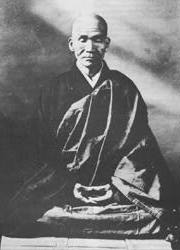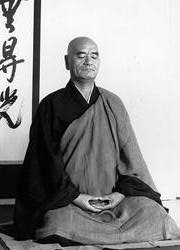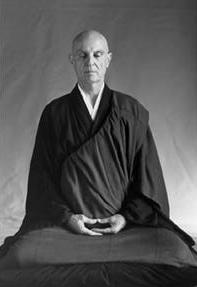 |

Kodo Sawaki Roshi (1880-1965)
Taisen Deshimaru Roshi (1914-1982)
Robert Livingston Roshi (b. 1933)
 Kodo Sawaki Roshi
(1880-1965) Kodo Sawaki Roshi
(1880-1965)
Kodo Sawaki, unlike most other Masters, refused to take charge of
the monasteries offered him during his lifetime. Nor did he ever settle
in a Temple or Dojo. Even after receiving the Shiho from his own
Master, Kodo Sawaki remained to the end an unsui-that is, a wandering
monk.
Both his parents having died when he was still a child, Kodo Sawaki
was left in the charge of a severe and brutal uncle. His youth was
spent working as a cleaning boy in a brothel and as an overseer at the
gambling tables. (His uncle, who was a gambler, engaged the boy to
ferret out the cardsharps and swindlers from among those with whom he
gambled.)
When the Sino-Japanese war broke out, the boy was immediately packed
off to the war front. Holding the notion that the boy, who was then just
fourteen, should show the respect due his country by dying for it, the
uncle warned Kodo Sawaki that he had better not come back alive if he
knew what was good for him.
The fourteen-year-old boy proved himself to be a highly competent
soldier, throwing himself into dangerous situations to save the lives
of his fellowman, and so he received many honors and was decorated for
distinguished action on the Sino-Japanese front. One day, after being
shot in the mouth, Kodo Sawaki was declared dead and flung into a pit
for corpses. Seriously wounded and unable to move (the boy was trapped
under the weight of thirty-odd corpses above him), he remained under
the rotting bodies for several days. Discovered when the bodies were
about to be incinerated, Kodo Sawaki was rescued and returned to Japan
as a war casualty.
Now sixteen years old, without family or friends, without food or
money, without anything but the shirt and pants that clung to his body,
he traveled by foot to the Temple of Eiheiji. It was a long and arduous
trip, and it took him four days and nights to get to Eiheiji. The
monks, taking Kodo Sawaki for a beggar-tramp (his clothes were but
rags) and a madman (the bullet wound he had received in the mouth
impaired his speech and made it difficult for him to speak), refused to
listen to him. Undaunted, the youth persisted in his request to be
admitted to the Temple. The Chief of the Temple, worn down by the young
man's insistence, finally took him in. So grateful was he to have been
allowed admittance to the Temple that, though very hungry (he hadn't
had a bite to eat for days), Kodo Sawaki kept his hunger to himself and
so remained for another two days without food and without sleep.
Despite the lack of food-he was almost starving by then-he was so
filled with joy that he could not close his eyes, even if he had wished
to. Delegated to pounding rice in the kitchen, as was the Sixth
Patriarch in the seventh century, Kodo Sawaki remained at Eiheiji for a
few years before taking to the road. It was during these subsequent
wanderings that he met the Soto Master Koho Roshi, from whom he
eventually received the Transmission.
After receiving the Shiho from his Master, Kodo Sawaki went to live
in an abandoned hermitage. Rarely sleeping for fear of wasting time,
the Master spent his days practicing Shikantaza and his nights studying
the Shobogenzo. And for food he ate nothing but rice and
beans-uncooked-to save time.
After many years of this, and as ever refusing to affiliate himself
with any Temple or monastery, Kodo Sawaki again took up the life of a
wandering monk. Followed by a few devoted disciples (among them Taisen
Deshimaru), the Master brought the teaching to the people in the
distant corners of Japan, from the cities to the fishing villages, from
the universities to the prisons.
In i965, while on his deathbed, he gave Taisen Deshimaru the Kesa,
along with the Shiho.
Today two statues, one of Kodo Sawaki and one of Taisen Deshimaru,
stand at the entrance to the Buddhist University of Komazawa.
From Deshimaru, Taisen (ed. Philippe Coupey). The Voice of the
Valley.
 Taisen Deshimaru Roshi
(1914-1982) Taisen Deshimaru Roshi
(1914-1982)
Born in the Saga Prefecture of Kyushu in 1914 of an old Samurai
family, Taisen Deshimaru was raised by his grandfather, who was a
Samurai Master before the Meiji Revolution, and by his mother, a devout
follower of the Buddhist Shinshu sect. Though, unlike Kodo Sawaki
before him, Deshimaru had a happy childhood, he was nonetheless
tormented, even at an early age, by this ephemeral world of birth and
death. Nembutsu, as practiced by his mother, did not fulfill him. Nor,
finally, did his long study of the Christian Bible, under the guidance
of a Protestant minister. Deshimaru's contacts with theologians and
priests left him unsatisfied, for Christianity, which had first
captured his full attention, seemed in the long run to be hopelessly
lost in abstract poetic imagery. It lacked, for him, the practical,
while contemporary education (Deshimaru was graduated from the
University of Yokohama), confined within its time-conditioned concepts,
lacked the spiritual. In his search for a means to set his mind at
rest, Deshimaru left off his study of Christianity and returned to his
own religion-that of Buddhism. Consequently, he came into contact with
the Rinzai teachings. Eventually becoming dissatisfied with Rinzai as
well and feeling unfulfilled in his work as a businessman, Deshimaru
began a series of meanderings which eventually led him to the Soto
Master Kodo Sawaki.
Arriving for the first time in the Master's hermitage, he found Kodo
Sawaki sitting erect on a cushion with his back to the door. Overcoming
his initial shock-the Master was sitting in the perfect posture of the
Buddha, and this alone left Deshimaru momentarily speechless-he
addressed the man. Kodo Sawaki did not reply, and Deshimaru was left
standing awkwardly in the doorway. He repeated himself, and again (as
when Eka addressed Bodhidharma in their first encounter) there was no
reply. But unlike Bodhidharma, who left Eka standing for two days
before answering, Kodo Sawaki finally said: "I have been waiting
impatiently for your visit." The Master uttered these words without
turning to his visitor, without the slightest movement, without even
lifting his eyes.
With the great joy that is felt when one's wanderings have come to
an end and one has found a true Master, Deshimaru did gassho, and in
that moment he became Kodo Sawaki's disciple.
Following directly in his Master's footsteps, he devoted himself,
body and mind, to the practice of Shikantaza. However, after the
Japanese attack on the American base at Pearl Harbor, circumstances
obliged the disciple and his Master to part company-we will certainly
lose the war," Kodo Sawaki said at their leave-taking. "Our homeland
will be destroyed, our people annihilate . . . and this may be the last
time we see one another. Nevertheless, love all mankind regardless of
race or creed."
Deshimaru was being sent on a dangerous mission over enemy waters,
and the Master knew this, and so he removed his old Rakusu (a material
worn over the neck and breast, symbolic of a Kesa) and gave it to his
disciple, along with his notebook containing the Shodoka. "Respect and
have faith in what I have given you," said the Master, "and you will
have good karma."
Deshimaru, whose job it was to direct a Japanese-controlled copper
mine off Indonesia, shipped out in a convoy of freighters and
destroyers. However, once they were beyond Japanese-controlled waters,
submarines of the United States Navy made devastating attacks on the
convoy, sinking one ship after the other. Deshimaru's freighter was
carrying a cargo of dynamite, and whenever a torpedo skirted the bow or
the stern, crew members, beyond themselves with fear, plunged blindly
overboard. The ship was in the hands of a capable captain, however, and
so Deshimaru sat on the forecastle below the captain's cockpit in the
perfect full lotus. He sat, calmly and erect, on a case of dynamite.
Forty days later Deshimaru's unarmed freighter pulled into the Mekong
and threw anchor.
Of a convoy of fifty-one ships, his alone arrived at its
destination. The freighter, incidentally, was called The Supreme Law of
the Buddha.
Finding himself on the island of Bangka, off the coast of Sumatra,
Deshimaru taught the practice of zazen to the Chinese, Indonesian and
European inhabitants. However, saddened and depressed by the
comportment of his own people (the Japanese Army of Occupation was
indiscriminately torturing and executing large numbers of the local
inhabitants), Deshimaru actively took up the Bangka people's cause.
Tagged as a resistance fighter against the Imperial Japanese Army,
Deshimaru was thrown into prison. Despite malaria, the intense heat,
the flies, the filth, the lack of food and water, and his scheduled
execution, the man sat facing a wall in his cell, with his Master's
Rakusu about his neck.
Directly before the mass execution was to take place, word arrived
from the highest military authorities in Japan, and Deshimaru, along
with all those awaiting execution with him, was set free. (The Japanese
Military Tribunal that convened after the war ordered the execution of
all those responsible for the Bangka Affair).
Recovered from a life-and-death bout with malaria, Deshimaru again
set sail, this time for the island of Billiton, where he was to direct
a Dutch-captured copper mine. His ship had hardly set out when American
fighter planes swept down on it. Their rockets scored direct hits, and
Deshimaru, who was sitting on the bridge in Shikantaza, was hurled
clear of the sinking ship and into the sea. Utterly alone, and without
a life jacket-with nothing, in fact, except the old Rakusu and notebook
on him-he remained afloat for a day and a night. Discovered eventually
by a Japanese PT boat, Deshimaru was pulled to safety Though his
clothes were torn and half gone, the Rakusu came out intact. And the
Master's notes, written in ink, were as fresh and clear as when they
were first penned.
When the war was finally over, Deshimaru was taken prisoner by the
Americans and incarcerated in a prisoner-of-war camp in Singapore.
After many more months of hardship (corned beef rations being their
sole luxury), Deshimaru, along with the other twenty thousand Japanese
war prisoners in the same camp, was returned to his homeland.
Deshimaru rejoined his Master and remained by his side until the
latter's death fourteen years later. He received the monastic
ordination shortly before the Master fell ill, and he received the
Transmission (the Shiho) while Kodo Sawaki was on his deathbed. As
material evidence, the Master gave his disciple the Kesa. So the
Transmission and the Kesa, handed down from Buddha to Buddha and from
Patriarch to Patriarch, were passed on from Master Kodo Sawaki to
Master Taisen Deshimaru in the year 1965.
"In India during the time of Bodhidharma," said the dying Kodo
Sawaki, "Buddhism was in a state of decadence. And so Bodhidharma's
Master told his disciple to take the teachings with him to the West.
Likewise in Japan, Buddhism is now dead. And so you, my Dharma heir,
you alone, who know the true teachings of the Buddha-take them with you
to the West so that Buddhism may again flourish. All people who do
zazen are my disciples."
After burying Kodo Sawaki's skull in the ground outside the Dojo,
Deshimaru sat immobile in the perfect posture of the Buddha for
forty-nine days. Then he left his homeland for the West.
From the time of Buddha to that of Bodhidharma, seven hundred years
went by, from Bodhidharma to Dogen another seven hundred years; and
from Dogen to Deshimaru seven hundred years.
From Deshimaru, Taisen (ed. Philippe Coupey). The Voice of the
Valley.
 Robert Livingston
Roshi (b. 1933) Robert Livingston
Roshi (b. 1933)
Robert Livingston was born in New York City in January 1933. He grew
up in New York, California and Texas, and graduated from Cornell
University. He spent two years in Japan and Korea in the U.S. Army in
the early 1950's, and studied and traveled in Europe after his Army
discharge. After three years as a registered representative of the New
York Stock Exchange, he returned to Europe where he was head of an
international financial services corporation for ten years. He then
retired from the business world and began practicing Zen with Master Deshimaru in Paris.
He became a close disciple of Deshimaru, who made Livingston a Zen
teacher. Before his death in 1982, Deshimaru asked him to go to America
and open a Zen dojo and teach true Zen practice in the United States.
Livingston Roshi founded the American Zen Association and the New
Orleans Zen Temple in 1983, and has been teaching in this country ever since.
|

